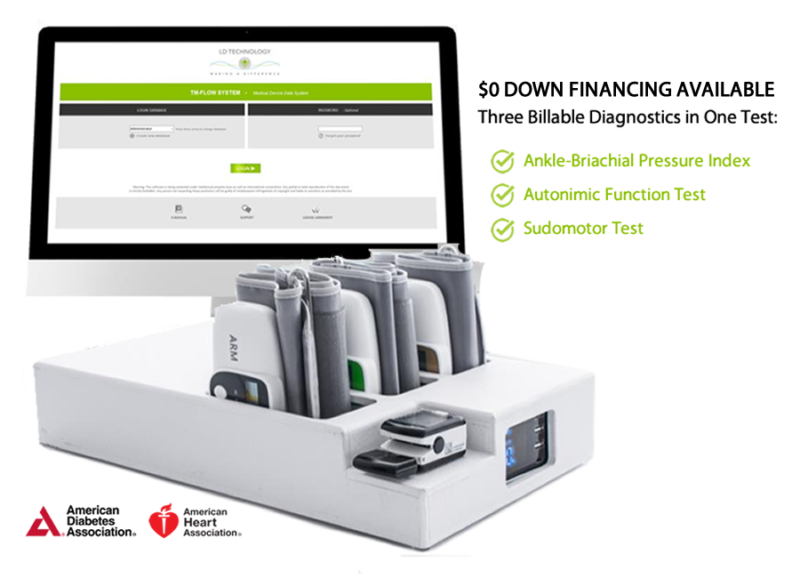Frequently Asked Questions
The TM Flow device offers numerous benefits for medical practices, including non-invasive and accurate testing, early detection of autonomic and arterial dysfunctions, and comprehensive diagnostics that reduce the overall cost of patient care. Additionally, the device’s tests are easy to bill with multi-code diagnostics, making it a valuable investment for enhancing patient care and optimizing practice efficiency. It also supports compliance with standards of care recommended by leading health organizations.
Yes, the TM Flow device is covered by Medicare and most private pay carriers. Specific CPT codes, such as 95921 for cardiovagal innervation and 93923 for ankle-brachial pressure index, ensure that the diagnostics are easy to bill. Coverage and reimbursements may vary depending on the Medicare locality, but the comprehensive diagnostics offered by the TM Flow device are widely recognized and supported by insurance providers.
Autonomic nervous system testing is crucial for diabetes and cardiovascular patients because it helps in the early detection of autonomic neuropathy, which is a common complication in these conditions. Early detection through ANS testing allows for timely intervention and management, reducing the risk of further complications. The American Diabetes Association recommends ANS testing as a standard of care for patients with Type 1 and Type 2 diabetes, highlighting its importance in effective diabetes management.
The TM Flow device is an advanced, non-invasive diagnostic tool designed to perform a series of tests that aid in the identification and early detection of autonomic nervous system (ANS) and arterial dysfunctions. It provides quantitative assessments of the ANS, helping to distinguish between early and late stages of autonomic neuropathy. The TM Flow device is particularly valuable for cardiovascular and diabetic autonomic neuropathy (DAN) testing, making it an essential tool in diabetes management and cardiovascular assessments.
TM Flow in Santa Fe
As a neurologist in Santa Fe, I treat many patients with diabetes. Though this condition can be managed effectively using traditional methods like medication and lifestyle changes, there are some patients who do not respond as well to conventional treatment. A study published in the Journal of Clinical Endocrinology & Metabolism found that nearly 50% of people with Type 1 diabetes have small fiber neuropathy (SFN). The TM Flow test helps physicians diagnose SFN by measuring blood flow at the extremities of their patients’ bodies. This approach allows them to identify patients who are at risk for nerve damage before any symptoms appear—and it’s especially useful for those who have already been diagnosed with Type 1 diabetes but have not yet experienced any symptoms of this condition
TM Flow is helping neurologists in Santa Fe to evaluate patients with diabetes in a more complete way.
A new diagnostic test for small fiber neuropathy, TM Flow is a non-invasive test that can be performed in the doctor’s office. The test is simple and painless, with no needles or injections needed. It measures vibration sense over different parts of the body by applying a gentle mechanical vibration to each location until it’s palpable by touch, then records how long it takes before you feel it. The results are recorded on a graph, which looks like this:
The chart above represents what would be considered normal vs abnormal sensation. If your graph falls below the blue line (denoting 20/20 vision), your condition is likely more severe than what can be seen on this scale — which means that you may have some degree of damage to your nerves or small blood vessels throughout your body that we don’t know about yet!
A New Way to Test for Small Fiber Neuropathy
A new, non-invasive method for testing small fiber neuropathy (SFN) is gaining popularity among neurologists in Santa Fe, NM. The test is called TM Flow and it is a fast and easy way for patients to give their doctors information about their level of SFN.
The conventional method of testing for SFN requires that patients have a nerve conduction study done in the lab at a hospital or clinic. It can take several hours plus travel time, which often means missing work or school the next day. The lab procedure can be uncomfortable because electrodes are attached to different parts of the body while electrical impulses are sent through nerves in order to measure how they respond; this may cause pain or tingling during the test itself.
Testing and Treatment in the Same Day
You can get both a diagnosis and treatment in the same day with TM Flow. No more waiting around for weeks on end to find out what’s wrong, or having to go through multiple tests before you get an answer. After your initial consultation with your doctor (which takes about 30 minutes), you’ll be able to take part in a 45-minute test that will help determine whether or not TM Flow is right for you. If it is, then you can sign up for a 90-minute treatment session later that day or the next week!
So if you’re suffering from symptoms such as headaches or muscle pain that interfere with everyday life or activities like exercise or work—and if these symptoms aren’t related to any other health conditions—then consider giving TM Flow a try!
Clinic Adopts New Diagnostic Method
You can get a diagnosis of your condition in a few minutes without the need for a doctor to be present.
As a result, treatment can be started immediately and patients can be treated in their homes.
Better Health Outcomes, Lower Costs
The TM Flow is a simple, non-invasive test that can be done in the office and takes about 15 minutes. Based on your responses to questions about your health and lifestyle, the tool will provide you with a score from 0-100. Depending on where you fall in this range, it may be time for you to seek additional testing or treatment options.
The TM Flow is not just another test or screening—it’s designed to help patients avoid unnecessary medication or surgery in addition to guiding treatment decisions by revealing their true disease state (as opposed to what they believe their disease state is). The goal is for people with SFN to have better health outcomes at lower costs by providing them with more information about their condition.
Is it Possible to Test for Small Fiber Neuropathy (SFN) in a General Practice?
For people who have been diagnosed with small fiber neuropathy (SFN), a condition that causes chronic pain, numbness and tingling in the arms and legs, there are no specific diagnostic tests for SFN. However, it is possible to test for this type of nerve damage using a procedure called the TM Flow Test. This test requires no needles or blood samples; it’s non-invasive and can be done in a doctor’s office or clinic by any licensed healthcare professional trained to perform the TM Flow Test.
The TM Flow test takes about 10 minutes to complete and is covered by many insurance providers across the country.
Many patients with small fiber neuropathy (SFN) are being misdiagnosed or mismanaged because this condition is difficult to diagnose and there is currently no accepted standard of care. The TM Flow test offers a simple, cost-effective way for physicians to accurately diagnose this condition so that their patients can get the treatment they need.
Many patients with small fiber neuropathy (SFN) are being misdiagnosed or mismanaged because this condition is difficult to diagnose and there is currently no accepted standard of care. The TM Flow test offers a simple, cost-effective way for physicians to accurately diagnose this condition so that their patients can get the treatment they need.
The TM Flow Test enables physicians to objectively confirm whether or not their patient has SFN using a rapid, non-invasive test that takes less than 10 minutes to perform. If the results indicate that the patient does have SFN, then doctors can use this information in combination with other diagnostic tests to select an appropriate treatment plan based on those findings.
Conclusion
In conclusion, the TM Flow is a valuable tool for neurologists that can help them make more accurate diagnoses and treat patients with diabetes in a more complete way. This test can also be used as part of an overall diagnosis or treatment plan for patients with small fiber neuropathy (SFN).
RSS FEED
- The TM Flow is a highly reimbursable diagnostic in Portland, OR
- Pain Clinics in Albuquerque, NM Adopt the TM Flow as Gold Standard
- Neuropathy in Philadelphia, PA can be detected with the TM Flow device
- Pain Management Clinics in Dallas, TX are Using the TM Flow to Diagnose Symptoms
- Unlocking the Potential of ANS Testing: Insights for Healthcare Providers
- Neuropathy clinics in Savanah, GA use the TM Flow
- Come to Charleston, WV to Get a TM Flow
- How the TM Flow will maximize your physician practice in Boise Idaho
- Doctors in Pittsburg, PA are using the TM Flow for the treatment of neuropathy
- Which Patients Require ANS Testing?

